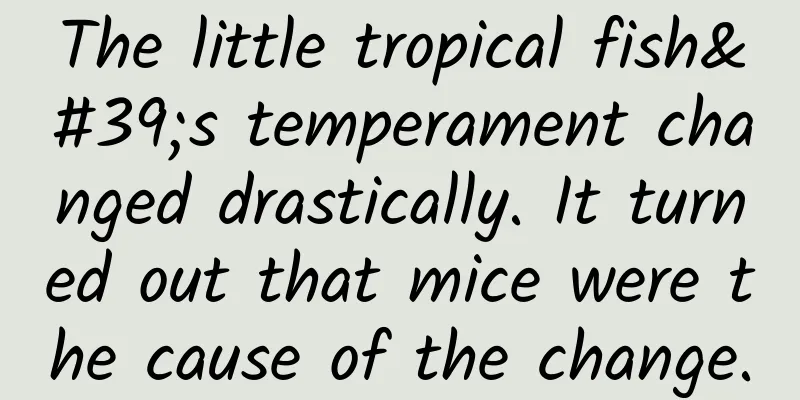The little tropical fish's temperament changed drastically. It turned out that mice were the cause of the change.

|
Image credit: Rachel Gunn Pomacentridae is a kind of happy little fish that mainly lives in tropical and subtropical areas. Most of them live in the ocean, and a few are distributed in freshwater or brackish waters. These small fish often appear among the coral reefs on the seabed and eat some small crustaceans, plankton or algae. Amphiprion ocellaris is probably the most famous damselfish (Image source: Ritiks, Wiki) These small fish are very careful to protect their territory and will not allow other fish to invade. Some damselfish even spend most of their lives in their own territory (such as the red saw-shaped damselfish, Stegastes adustus). Some damselfish will also cultivate algae in their territory as food, so they are also known as "undersea farmers". Some algae are high in fiber, and damselfish lack the enzymes to digest them, so they only eat other algae that taste better, such as Polysiphonia urceolata. The "undersea farmers" will remove the unpalatable algae and spit them out of the "field", leaving only the tasty algae. They will also remove the sediment on the rocks to leave room for the algae to grow. These damselfish will carefully take care of their "fields" and remove the intruding sea urchins or starfish. Scientists have discovered that a smart damselfish (Stegastes diencaeus) will even protect the mysid shrimps that swim in its territory in order to eat a bite of delicious algae, because the feces of mysid shrimps are fertilizers for algae, which can make them grow better. Although damselfish also eat similar small creatures, they seem to be particularly lenient towards these small shrimps. Juvenile longfin damselfish (Photo credit: Laszlo Ilyes, Flickr) In recent years, some species of Plagtroglyphidodon lacrymatus seem to have changed their habits, enclosing larger territories but becoming less hostile to outsiders. What happened to make these territorial fish give in? Pearl-spotted damselfish (Photo source: Wiki) After careful investigation, the researchers discovered that the key was actually related to mice. When we talk about rats, we naturally think of the dark, damp, garbage-filled corners of the city. It is hard to imagine how the beautiful coral reefs and the cute little fish living there would be affected by them. These small fish with strange behavior live near the Chagos Islands in the Indian Ocean. Originally, there were no rats on these islands. As early as the 18th century, a group of rats came here with European fleets. Since they had no natural enemies and ate everything, they became more and more rampant and reproduced generation after generation. This is a typical biological invasion. Rodent invasion is very difficult to eradicate because their survival ability is so strong. Their diet ranges from grains to fruits, from insects to chickens, and even eggshells and human and animal feces. Now more than 80% of the world's islands have traces of rats. Under natural conditions, islands have been isolated from the mainland for a long time and have developed very unique ecosystems. Many native species have been hit hard by the emergence of invasive species, and the dodo has suffered greatly. Dodo skeleton (left) and model (right) (Image source: Bazza Da Rambler, Oxford University Museum of Natural History) The extinction of the dodo was caused not only by hunting by humans, but also by biological invasion. As humans arrived on the island of Mauritius, rats, cats, dogs, monkeys and other animals also came along, leaving the dodo with less and less living space, causing it to completely disappear within 200 years of being discovered by humans. Rat Island is an uninhabited island in the Aleutian Islands. Its name literally means "Rat Island". In 1780, a Japanese ship ran aground here, and the rats on the ship ran to the island and became an invasive species. This was the first time rats appeared on the island. Later, the rampant rats caused the extinction of many seabirds here. It was not until people launched a large-scale rat eradication campaign that some seabirds came here to build nests again. Back to the Chagos Archipelago in the Indian Ocean, some islands here have rat invasions and some do not. Seabirds, especially those that nest in groups, are very vulnerable, as their eggs and chicks are a source of food for rats. Dr. Rachel Gunn from the School of Biology at Lanchester University in the UK found that seabird densities on islands without rat invasions were 720 times higher than on islands with invasions. As the number of seabirds decreases, there is much less guano. Guano is rich in nutrients such as nitrogen, which can promote the growth of corals, some seabed plants and marine fish, and is essential for the biodiversity of coral reefs. Around islands where mice live, nitrogen in the ocean has decreased by 251 times, causing the algae on the coral reefs to lose most of their nutrient sources. A free-flying Atlantic puffin (Photo credit: Flickr) In the waters around islands without rat invasion, the "farmer" damselfish still guard their territory diligently. They will try their best to drive away any fish that dare to invade their territory, because the algae in their "fields" are rich in nutrients, and it is worth it even if it costs energy to fight. On the islands where rats have invaded, the damselfish are not so concerned. They seem to disdain to spend energy to care for this barren "farm". Although they still take care of their "fields", they will remove weeds and find ways to increase the nutrients of algae, but these efforts are obviously not worth mentioning compared to the nourishment of bird droppings. Damselfish become less aggressive near islands infested with rats (Image source: Reference [4]) Ecosystems are in a delicate balance for a long time, and changes in any one factor will cause a series of changes in the entire system. The emergence of mice has reduced the number of seabirds, which has affected the fish in the ocean, and this has caused changes across ecosystems. In order to restore the previous ecosystem, it seems that the most effective way is to eliminate rats. Although it is difficult to eradicate rats, there are many successful cases. However, the current method of eliminating rats is mainly to drop poison bait from the air on the island. It is not known how harmful this will be to other creatures on the island. (Image source: Flickr) In the long run, there are still many benefits if rats can be eliminated. At least it can expand the population size of damselfish, which is also conducive to enriching the community composition of coral reefs and enhancing the resilience of the ecosystem. |
<<: I want to rub it! It is the prototype of Pikachu and the leader in cuteness
Recommend
An egg falling from a high altitude can kill a person, so why can a cat jump from the 32nd floor and survive?
Editor’s Note: Please do not conduct any tests or...
The six new features of iTunes Connect (latest news from the App Store!)
iTunes Connect is constantly being updated, and t...
Gong Peiyuan, Vice President and Executive Partner of Gartner: Analyzing the five key areas of "new infrastructure"
Source: Communication World, author: Liu Tingyi R...
Coming next month? Apple iOS 15 has five major features that are really useful
In recent years, Apple's appeal has been decl...
Daily Market Review Brother Saturday Column Understanding Leading Stocks 2020-2021 Practical Tutorial Updates
Daily Market Review Brother Saturday Column Under...
Why is it so difficult for short video creators to monetize?
Behind the spectacular rise of short videos are a...
Why do unoccupied houses age so quickly?
I don’t know if you have ever seen those vacant o...
There are many tricks for fake close buttons on apps! The Ministry of Industry and Information Technology launches a special rectification campaign on the Internet
[[413279]] App splash screen ads are nothing new....
Qinling giant panda family has four generations living under one roof
In the past two days, the news that the Qinling g...
How to make the Guangzhou wedding mini program? How much does it cost to customize and develop a wedding app?
In recent years, the wedding market has shown a m...
E-commerce operation: holiday promotion traffic field!
In the mobile Internet environment, new consumer ...
Is growing taller painful? Uncovering the "little episodes" in the process of children growing taller →
Spring is the season of revival and the "gol...
How to get more customers smartly?
If we divide the company's customer base base...
Teach you how to open the Douyin "product showcase" step by step
There are three ways to monetize Douyin: product ...
Why does aging occur "cliff-like" after the age of 70? Do these things to slow down aging
This article was reviewed by Zhu Hongjian, Chief ...









